Key takeaways
- Edmodo creates a virtual classroom that empowers shy students to participate actively by providing a less intimidating space for expression.
- Activist teacher resources encourage critical thinking and social awareness, fostering a culture of reflection on real-world issues.
- Effective class discussions benefit from clear expectations, open-ended questions, and timely teacher engagement to promote thoughtful dialogue.
- Edmodo enhances student engagement by transforming participation from passive listening to active contribution, encouraging deeper interaction and reflection.
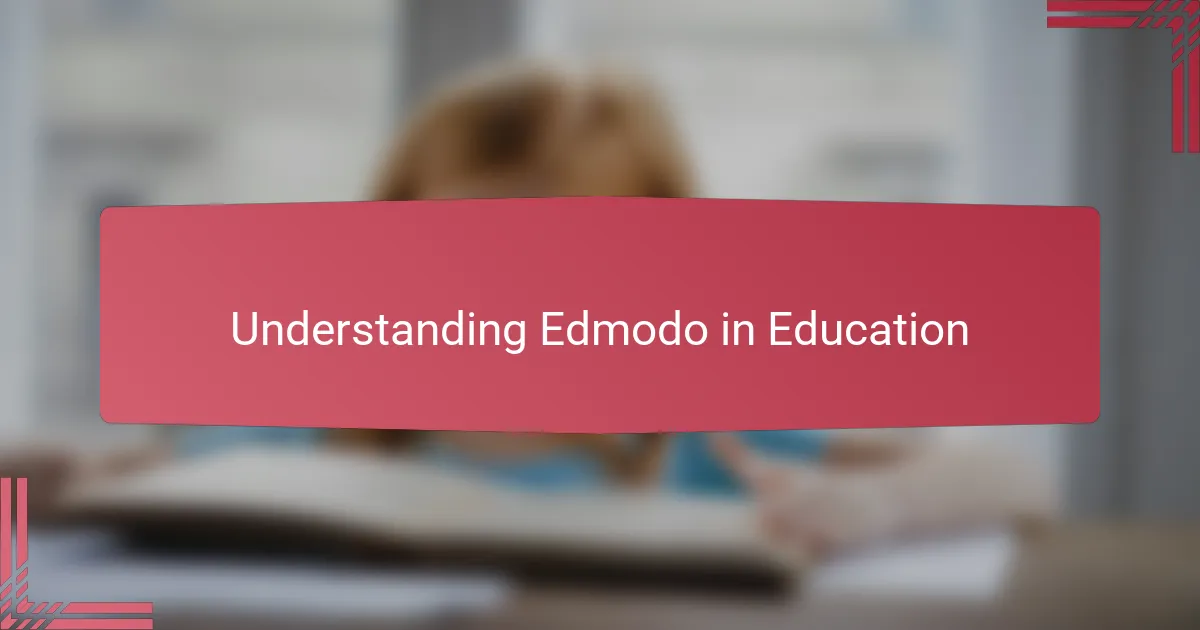
Understanding Edmodo in Education
Edmodo serves as a virtual classroom space where students and teachers can connect beyond the physical walls of a school. From my experience, it’s like having a constant back channel for class discussions—something I found incredibly empowering for shy students who rarely spoke up in person. Have you ever wondered how technology can transform the dynamics of a classroom conversation?
What strikes me most about Edmodo is how it blends social media’s familiarity with educational purpose. This balance often makes participation feel less intimidating and more natural for students, which encourages deeper engagement. When I first used it, I noticed hesitant voices becoming more confident, simply because the platform offered a different mode of expression.
At its core, Edmodo is a tool designed to foster interaction, reflection, and collaboration among learners and educators alike. But it’s not just about technical features; it’s about how we, as activist teachers, can leverage these digital spaces to create more inclusive, democratic classrooms. Isn’t that what education should be about—giving every voice a chance to be heard?
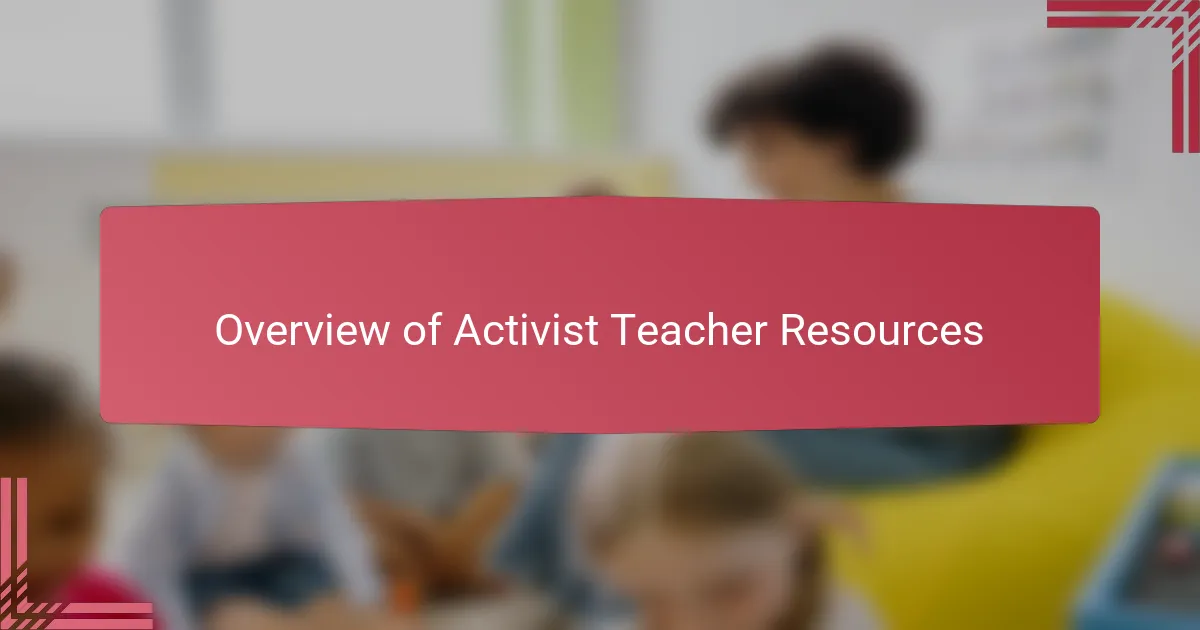
Overview of Activist Teacher Resources
Activist teacher resources have always intrigued me because they go beyond textbooks and lesson plans. These resources are about empowering educators to challenge the status quo and nurture critical thinking in students. In my experience, having access to materials that encourage questioning and social awareness can truly transform how I approach teaching.
I recall the first time I stumbled upon a collection of activist teacher tools—it felt like a breath of fresh air. Suddenly, I wasn’t just imparting knowledge; I was fostering a classroom culture where students felt encouraged to reflect on real-world issues. Isn’t that the kind of learning that sticks with you?
What I appreciate most about activist teacher resources is their diversity and adaptability. Whether it’s lesson guides, discussion platforms, or community connections, these resources support teachers in making education a catalyst for change. Don’t we all want our classrooms to be places where students develop both knowledge and conscience?
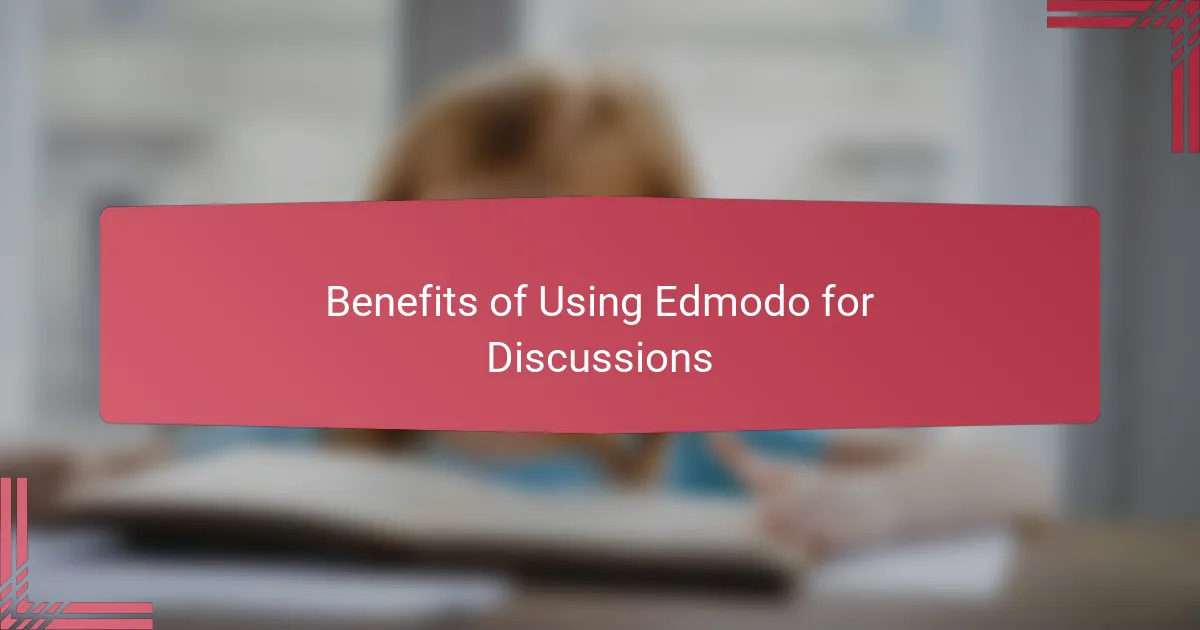
Benefits of Using Edmodo for Discussions
One of the biggest benefits I’ve noticed with Edmodo is how it levels the playing field in discussions. Students who usually stay quiet in class suddenly find their voice online, where the immediate pressure of speaking out loud disappears. Have you ever seen a usually reserved student suddenly offer thoughtful insights through a typed response? That moment, to me, highlights the platform’s power.
Another thing I appreciate is the way Edmodo keeps the conversation going beyond the school bell. It’s not just about what happens during class time; it encourages ongoing reflection and interaction. I’ve watched students engage thoughtfully with their peers’ ideas late into the evening, which tells me they’re genuinely processing the material—and that deeper engagement makes a real difference.
What also stands out is the ease with which Edmodo allows me to track participation and guide discussions. I can respond in real time or later, providing personalized feedback that feels meaningful. Doesn’t that kind of ongoing dialogue create a more connected classroom community? From my experience, it absolutely does, and that connection is the foundation of a truly activist approach to teaching.
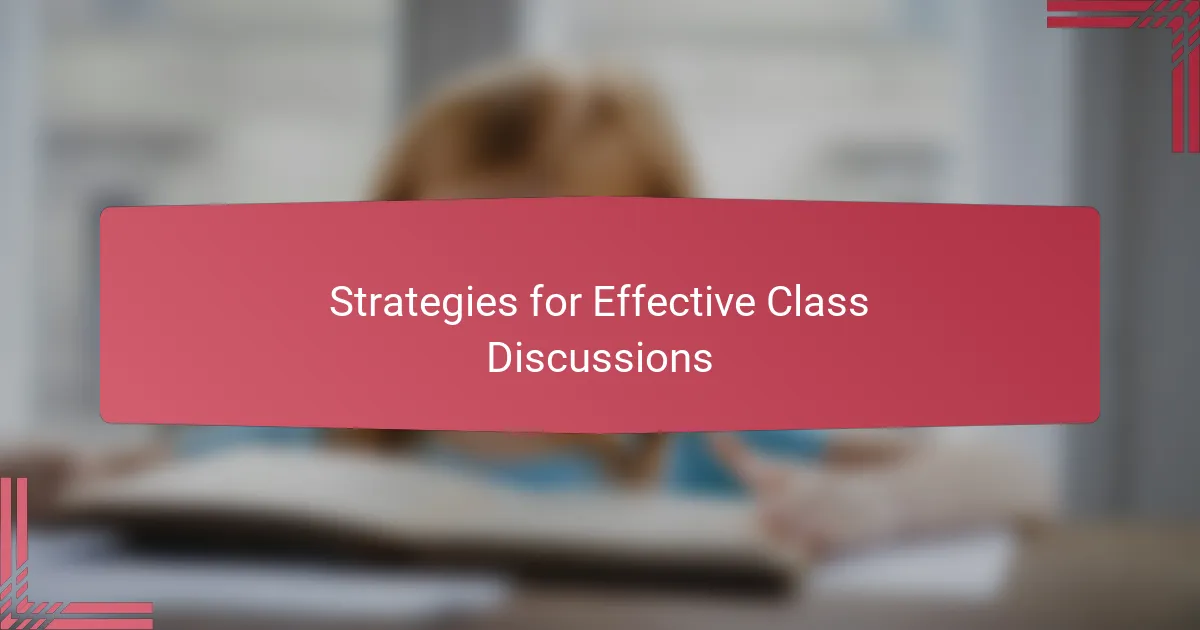
Strategies for Effective Class Discussions
When facilitating effective class discussions, one key strategy I rely on is setting clear expectations from the start. I’ve found that when students understand the purpose and norms—like respecting diverse opinions and building on each other’s ideas—they participate more thoughtfully. Have you ever noticed how a shared understanding of “how to talk” can completely change the flow of conversation?
Another approach I’ve embraced is using open-ended questions that invite reflection rather than simple yes-or-no answers. This technique encourages deeper thinking and allows students to explore their perspectives without fear of being right or wrong. From my experience, questions that spark curiosity also spark enthusiasm—and that’s the kind of energy every discussion needs.
Lastly, I can’t overstate the importance of timely and thoughtful teacher responses during discussions. Jumping in at the right moment to acknowledge, challenge, or expand on student contributions helps keep momentum going. I remember once when a simple follow-up question I posed led a quiet student to share a powerful story—proof that how and when we engage can transform a class dialogue.
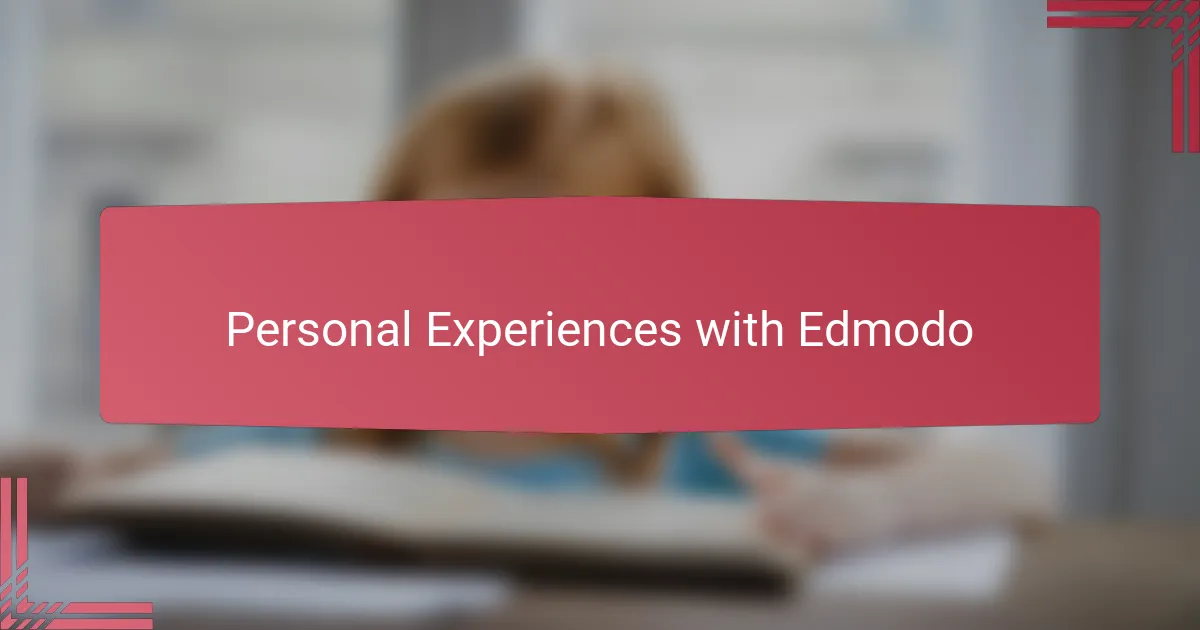
Personal Experiences with Edmodo
Using Edmodo for class discussions has genuinely changed the way I connect with my students. I remember one semester when a student who was usually silent in class started sharing detailed reflections online—it was like discovering a new dimension to her voice. Have you ever noticed how sometimes words flow more freely behind a screen than face-to-face?
There was also a time when a heated debate erupted in our Edmodo group, yet it remained respectful and insightful. Watching students navigate disagreement with empathy made me realize how crucial these virtual spaces are for teaching constructive dialogue. Isn’t it powerful to witness young people learning to listen as much as they speak?
What surprises me most is how Edmodo creates moments of unexpected connection. Late at night, I’ve seen students reply to peers’ posts with encouragement or new ideas, long after class had ended. Those moments remind me why fostering inclusive discussions online isn’t just an add-on—it’s essential for nurturing engaged, thoughtful learners.

Practical Tips for Activist Teachers
One practical tip I always share with fellow activist teachers is to establish clear guidelines for respectful dialogue right from the start. In my experience, setting these expectations online helps prevent misunderstandings and creates a safer space where every student feels valued. Have you ever noticed how a simple set of rules can transform chaotic discussions into rich, meaningful exchanges?
I’ve also found it essential to actively model the kind of critical yet compassionate conversation I want to see. When I respond thoughtfully to students’ posts—whether by asking probing questions or highlighting different viewpoints—it encourages deeper reflection and shows that their voices truly matter. This intentional engagement has often sparked some of the most insightful discussions I’ve witnessed on Edmodo.
Lastly, don’t underestimate the power of flexibility. Sometimes discussions take unexpected turns, or students express their views in ways that surprise you. Embracing those moments, rather than trying to control every thread, opens the door to genuine dialogue and growth. Have you ever been amazed at where your students’ conversations can lead when given the room to breathe? That freedom is what makes teaching with Edmodo so rewarding.
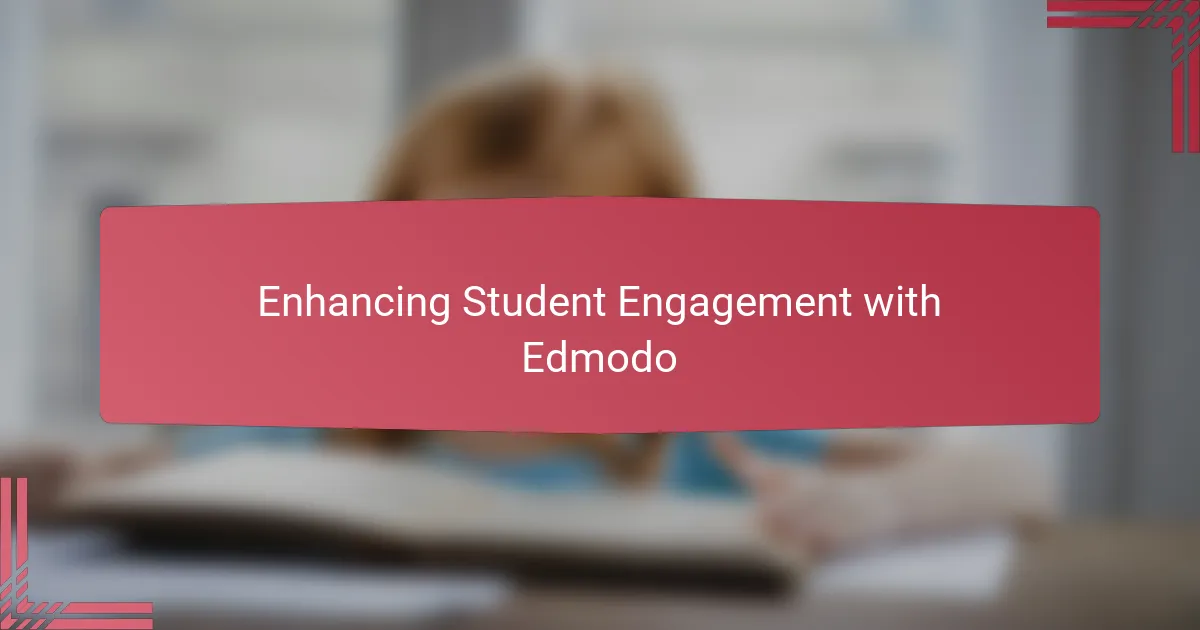
Enhancing Student Engagement with Edmodo
What I find truly exciting about Edmodo is how it transforms engagement from passive listening to active participation. I’ve noticed that students who might zone out during a lecture suddenly become fully involved when responding online. Have you ever seen a usually distracted student light up when given a chance to contribute at their own pace? That shift says a lot about how Edmodo can change the game.
The platform also invites a kind of interaction that feels safe yet stimulating. In my experience, students appreciate the time they have to think through their responses instead of jumping into instant debates. This reflective space often leads to richer, more thoughtful contributions—something I’ve found rare in traditional classroom discussions.
Edmodo’s intuitive notification system keeps students connected without feeling overwhelmed. I’ve observed that gentle nudges to revisit discussions or reply to peers encourage ongoing engagement long after class ends. Don’t you think that ongoing dialogue is key to deepening understanding and building a real learning community? I certainly do, and Edmodo makes that possibility very real.